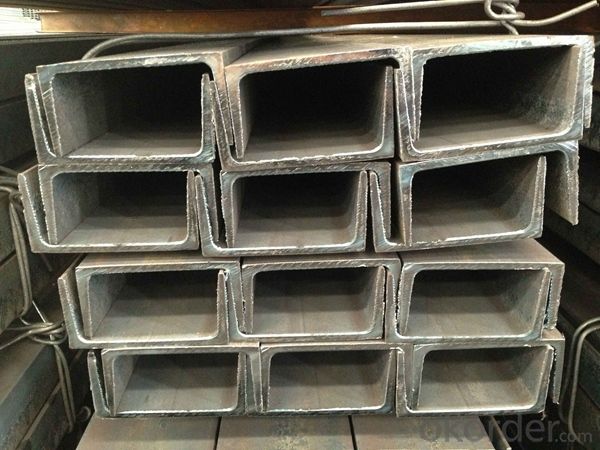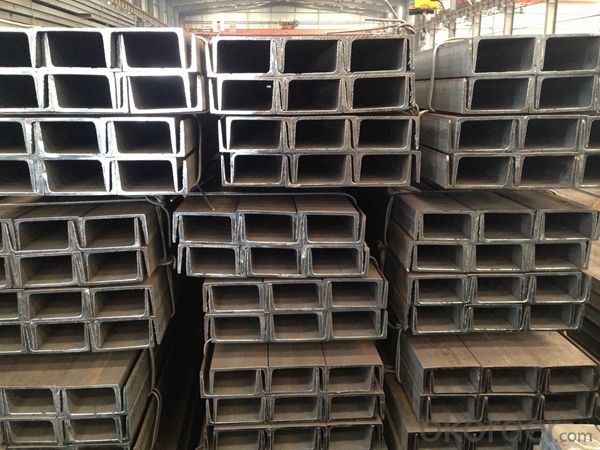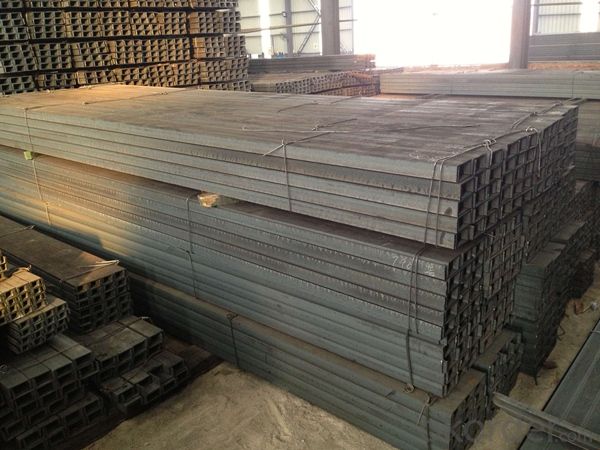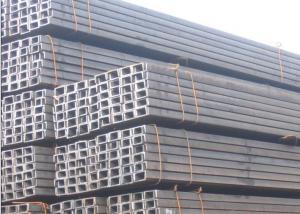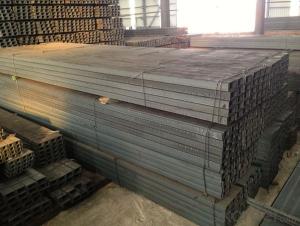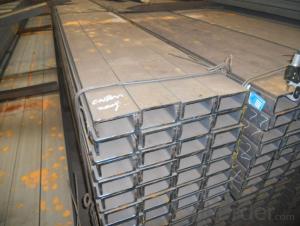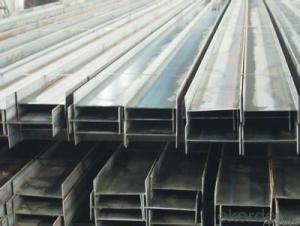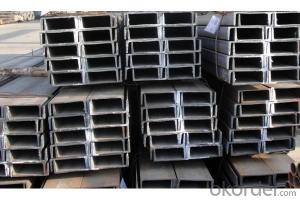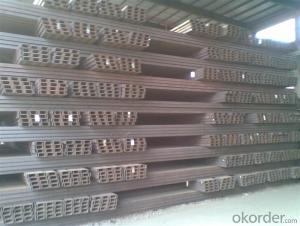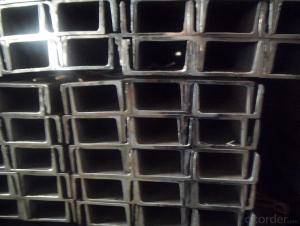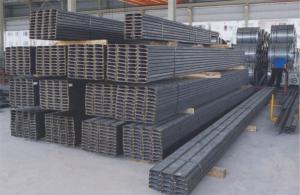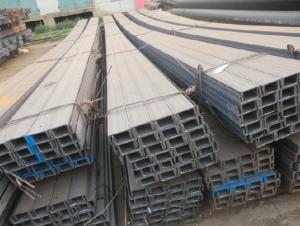Hot Rolled Steel U Channels beams for Construction of Warehouses
- Loading Port:
- Tianjin
- Payment Terms:
- TT OR LC
- Min Order Qty:
- 25 m.t.
- Supply Capability:
- 200000 m.t./month
OKorder Service Pledge
OKorder Financial Service
You Might Also Like
Product Description:
OKorder is offering Hot Rolled Steel U Channels beams for Construction of Warehouses at great prices with worldwide shipping. Our supplier is a world-class manufacturer of steel, with our products utilized the world over. OKorder annually supplies products to European, North American and Asian markets. We provide quotations within 24 hours of receiving an inquiry and guarantee competitive prices.
Product Applications:
Hot Rolled Steel U Channels beams for Construction of Warehouses are ideal for structural applications and general fabricating. The steel u channel can be applied to construction of warehouses, workshops, sport stadiums and car parks etc. In details, the steel u channel belongs to carbon structural steel which is applied to in the field of construction and machinery. The steel u channel is usually used for arch-itechtural structure, and they could be welded in order to support or hang a vari-ety of facilities. They are also usually used in combination with I beam. Generally,the steel u channel must possess perfect welding property, riveting property and mechanical property and so on.
Product Advantages:
Hot Rolled Steel U Channels beams for Construction of Warehouses are durable, strong, and resists corrosion.
Main Product Features:
· Premium quality
· Prompt delivery & seaworthy packing (7-10 days after receiving deposit)
· Corrosion resistance
· Can be recycled and reused
· Mill test certification
· Professional Service
· Competitive pricing
Product Specifications:
1.We supply high quality MS Channel at reasonable price, including Chinese standard, Japanese standard and so on.
Standard | GB/JIS |
Material Grade | Q235,SS400 |
Technique: | Hot Rolled |
Sizes as per chinese standard: | 50*37*4.5mm - 300*89*11.5mm |
Sizes as per japanese standard: | 50*25*3mm – 200*80*7.5mm |
Length: | 6meter, 9meter, 12meter |
Note: 1.we are also competent to provide our customers other MS Channel based on other sizes according to customer’s requirements.
2. The length of our ms channel could be cut into other meters as per customer’s requirements. For example, the channel in 6meters could be cut into 5.8meters in order to be fit in the 20ft container.
2. The detailed sections of MS Channel as per GB standard.are shown in the table-1:
GB U CHANNEL | Standard | Sectional | Dimension |
| Mass: |
(mm) | (mm) | (mm) | (mm) | ||
50X37 | 50 | 37 | 4.50 | 7.0 | 5.438 |
63X40 | 63 | 40 | 4.80 | 7.5 | 6.634 |
80x43 | 80 | 43 | 5.00 | 8.0 | 8.045 |
100x48 | 100 | 48 | 5.30 | 8.5 | 10.007 |
120x53 | 120 | 53 | 5.50 | 9.0 | 12.059 |
140x58 | 140 | 58 | 6.00 | 9.5 | 14.535 |
140x60 | 140 | 60 | 8.00 | 9.5 | 16.733 |
160x63 | 160 | 63 | 6.50 | 10.0 | 17.240 |
160x65 | 160 | 65 | 8.50 | 10.0 | 19.752 |
180x68 | 180 | 68 | 7.00 | 10.5 | 20.174 |
180x70 | 180 | 70 | 9.00 | 10.5 | 23.000 |
200x73 | 200 | 73 | 7.00 | 11.0 | 22.637 |
200x75 | 200 | 75 | 9.00 | 11.0 | 25.777 |
220x77 | 220 | 77 | 7.00 | 11.5 | 24.999 |
220x79 | 220 | 79 | 9.00 | 11.5 | 28.453 |
250x78 | 250 | 78 | 7.00 | 12.0 | 27.410 |
250x80 | 250 | 80 | 9.00 | 12.0 | 31.335 |
250x82 | 250 | 82 | 11.00 | 12.0 | 35.260 |
280x82 | 280 | 82 | 7.50 | 12.5 | 31.427 |
280x84 | 280 | 84 | 9.50 | 12.5 | 35.823 |
280x86 | 280 | 86 | 11.50 | 12.5 | 40.219 |
300x85 | 300 | 85 | 7.50 | 13.5 | 34.463 |
300x87 | 300 | 87 | 9.50 | 13.5 | 39.173 |
300x89 | 300 | 89 | 11.50 | 13.5 | 43.883 |
Table-1
3. The chemical composition of HR Channel Steel according to Q235B is shown in Table-2.
Alloy No | Grade | Element(%) | ||||
C | Mn | S | P | Si | ||
Q235 | B | 0.12-0.20 | 0.3-0.7 | ≦0.045 | ≦0.045 | ≦0.3 |
Table-2
Note: we are able to present our customers relevant SGS test report for chemical composition of HR Channel Steel.
4. The mechanical property of HR Channel Steel according to Q235B is shown in Table-3-1 and Table-3-2
Alloy No | Grade | Yielding Strength Point(Mpa) | |||
Thickness(mm) | |||||
≦16 | >16-40 | >40-60 | >60-100 | ||
≧ | |||||
Q235 | B | 235 | 225 | 215 | 205 |
Table-3-1
Alloy No | Grade | Tensile Strength(Mpa) | Elongation After Fracture(%) | |||
Thickness(mm) | ||||||
≦16 | >16-40 | >40-60 | >60-100 | |||
≧ | ||||||
G235 | B | 375-500 | 26 | 25 | 24 | 23 |
Table-3-2
Note: we are able to present our customers relevant SGS test report for mechanical property of MS Channel as customer’s request.
FAQ:
Q1: Why buy Hot Rolled Steel U Channels beams for Construction of Warehouses from OKorder.com?
A1: All products offered byOKorder.com are carefully selected from China's most reliable manufacturing enterprises. Through its ISO certifications, OKorder.com adheres to the highest standards and a commitment to supply chain safety and customer satisfaction.
Q2: How do we guarantee the quality of our products?
A2: We have established an advanced quality management system which conducts strict quality tests at every step, from raw materials to the final product. At the same time, we provide extensive follow-up service assurances as required.
Q3: How soon can we receive the product after purchase?
A3: Within three days of placing an order, we will begin production. The specific shipping date is dependent upon international and government factors, but is typically 7 to 10 workdays.


- Q: What is the purpose of a steel channel?
- The purpose of a steel channel is to provide structural support and reinforcement in various construction and engineering projects. The channel, typically made of steel, is shaped like a "C" and has two flanges on either side. The design allows for increased strength and stability, making it a popular choice in applications where load-bearing capacity is required. Steel channels are commonly used in the construction of buildings, bridges, and infrastructure, as they can withstand significant weight and force. They are often used as beams or columns to support the weight of floors, walls, and roofs. Additionally, steel channels are frequently employed in the installation of electrical systems, plumbing, and HVAC systems, serving as a conduit for wires, pipes, and ducts. In manufacturing, steel channels find utility in the creation of frames, racks, and other structures that require strength and durability. They are also commonly used in the automotive industry for the fabrication of vehicle frames, chassis, and body components. Their versatility and ability to resist bending and deformation make them an essential component in many industrial and commercial applications. Overall, the purpose of a steel channel is to provide structural integrity, support heavy loads, and enhance the overall stability and durability of a construction or engineering project. Its versatility, strength, and resistance to various forces make it a valuable component in a wide range of applications across multiple industries.
- Q: After the type of channel is not marked A or B, which shall be calculated?
- The type of channel is not calculated or selected according to the best principle when it is not marked "A" or "B":1) if it is the construction side, according to A model selection calculation, the most material, the lowest cost;2) if it is the owner, according to B model selection calculation, higher strength, greater safety factor.
- Q: Can steel channels be customized for specific applications?
- Yes, steel channels can be customized for specific applications. Steel channels are versatile and can be fabricated and modified to meet the specific requirements of different applications. Customization can involve altering the dimensions, shape, or material composition of the steel channel to suit the needs of the application. Additionally, various surface finishes and coatings can be applied to the steel channels to enhance their performance and durability in specific environments or industries. Customization ensures that the steel channels are tailored to fit the unique demands of the application, whether it be in construction, manufacturing, infrastructure, or any other industry where steel channels are utilized.
- Q: Can steel channels be used for mezzanine floors?
- Yes, steel channels can be used for mezzanine floors. Steel channels are commonly used as a structural component in mezzanine floor construction due to their strength and durability. They provide the necessary support and stability required for creating additional levels or platforms within a building.
- Q: What are the different methods for anchoring steel channels to a foundation?
- There are several different methods for anchoring steel channels to a foundation, depending on the specific requirements and load capacity of the structure. Some of the commonly used methods include: 1. Anchor Bolts: This is one of the most common methods used for anchoring steel channels to a foundation. It involves drilling holes into the foundation and inserting anchor bolts, which are then tightened using nuts and washers. These bolts provide a strong connection between the channel and the foundation. 2. Chemical Anchoring: In cases where drilling into the foundation is not feasible or desirable, chemical anchoring can be used. This method involves using epoxy resin or adhesive to bond the steel channel to the foundation. The adhesive is applied to the base of the channel, which is then pressed onto the foundation surface. Once cured, the adhesive provides a strong bond between the channel and the foundation. 3. Welding: Welding is another method used for anchoring steel channels to a foundation. This method involves welding the base of the channel directly to the foundation surface. It provides a permanent and strong connection, but requires skilled welders and may not be suitable for all applications. 4. Expansion Anchors: Expansion anchors are used when a temporary or removable connection is required. These anchors consist of a bolt or screw that is inserted into a pre-drilled hole in the foundation. As the bolt is tightened, it expands and wedges itself against the sides of the hole, providing a secure connection. 5. Concrete Embedment: In some cases, steel channels can be embedded directly into the concrete foundation. This method involves pouring the concrete around the channel, allowing it to fully surround and encase the steel. The concrete then hardens, providing a solid and permanent connection. It is important to consider factors such as load capacity, environmental conditions, and the specific requirements of the project when choosing the appropriate method for anchoring steel channels to a foundation. Consulting with a structural engineer or construction professional is recommended to ensure the proper selection and installation of the anchoring method.
- Q: What material does hot-dip galvanized channel belong to?
- Because the hot plating, and basically not stainless steel, I guess it should be carbon steel, which specific material is not clear, the most common is Q235 channel steel.
- Q: Can steel channels be used for signage structures?
- Yes, steel channels can be used for signage structures. Steel channels provide excellent strength and durability, making them suitable for supporting signs of various sizes and weights. They are often chosen for their ability to withstand weather conditions, ensuring the longevity of the signage structure. Additionally, steel channels allow for flexibility in design and can be easily customized to meet specific signage requirements.
- Q: What are the different load distribution techniques for steel channels in roof systems?
- Some of the different load distribution techniques for steel channels in roof systems include using purlins or trusses to evenly distribute the weight of the roof, employing structural bracing to provide additional support, and incorporating proper connections and fasteners to ensure stability and load sharing across the channels.
- Q: What are the design considerations for steel channels?
- When designing steel channels, it is important to take into account several key factors: 1. Load Capacity: The primary function of steel channels is to support loads. Therefore, it is crucial to determine the anticipated load capacity of the channel and ensure it meets the requirements of the intended application. This involves considering factors such as the weight of the materials being supported, potential dynamic loads, and safety factors. 2. Material Selection: Choosing the right material for the steel channels is essential. Factors such as required strength, corrosion resistance, and durability must be considered. Common materials used for steel channels include carbon steel, stainless steel, and aluminum, each with their own advantages and limitations. 3. Shape and Dimensions: The shape and dimensions of the steel channel significantly impact its performance. The choice of channel section (C, U, or Z-shaped) and the dimensions of the flanges and web determine the strength, stiffness, and ease of installation. It is important to ensure that the chosen shape and dimensions are suitable for the specific requirements of the application. 4. Connection and Fastening: The methods used to connect and fasten steel channels together or secure them to other components are critical for the overall stability and load-bearing capacity of the structure. The design of connections should be carefully considered to ensure proper load transfer, rigidity, and reliability. 5. Fabrication and Manufacturing: Consideration should be given to the fabrication and manufacturing methods used to produce the steel channels. This includes selecting appropriate manufacturing techniques, such as hot rolling or cold forming, and considering any constraints or limitations related to the chosen manufacturing process. 6. Environmental Factors: Steel channels may be exposed to various environmental conditions, such as moisture, temperature fluctuations, or corrosive substances. Design considerations need to account for these factors to prevent premature degradation or failure. Surface coatings or treatments can be applied to enhance corrosion resistance and protect the channels from environmental influences. 7. Cost and Availability: Lastly, the cost and availability of steel channels should be considered during the design phase. Balancing the desired performance requirements with the available budget and material availability can help optimize the design for practicality and cost-effectiveness. By carefully considering these design factors, engineers can ensure that steel channels are designed to meet performance requirements, are structurally sound, and are suitable for their intended application.
- Q: Can steel channels be used for supporting exterior shading devices?
- Certainly! Exterior shading devices can indeed be supported by steel channels. These channels are widely utilized in construction due to their robustness and resilience, making them an ideal choice for creating a strong framework for awnings, canopies, or louvers. By securely fastening these channels to the building's outer surface, a stable foundation is established for the shading device. Moreover, steel channels can be tailored and manufactured to meet particular design specifications, offering versatility in the installation process of exterior shading devices.
Send your message to us
Hot Rolled Steel U Channels beams for Construction of Warehouses
- Loading Port:
- Tianjin
- Payment Terms:
- TT OR LC
- Min Order Qty:
- 25 m.t.
- Supply Capability:
- 200000 m.t./month
OKorder Service Pledge
OKorder Financial Service
Similar products
Hot products
Hot Searches
Related keywords



